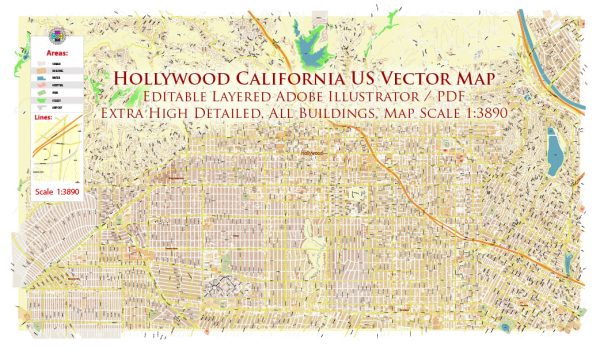Hollywood, a district located in the city of Los Angeles, California, is globally renowned as the entertainment capital of the world. The history of Hollywood is deeply intertwined with the development of the American film industry.
Vectormap.Net provide you with the most accurate and up-to-date vector maps in Adobe Illustrator, PDF and other formats, designed for editing and printing. Please read the vector map descriptions carefully.
Here’s a detailed overview of the urban history and street system of Hollywood:
Urban History:
- Early History:
- Hollywood was originally inhabited by the Tongva people before European settlers arrived.
- In the late 19th century, Harvey Wilcox and his wife Daeida envisioned a community and named it Hollywood, which eventually grew into a separate community outside Los Angeles.
- Early Development:
- Hollywood began to grow as a small independent community with citrus groves and ranches.
- The arrival of the Los Angeles Pacific Railroad in 1904 facilitated accessibility to the area.
- Rise of the Film Industry:
- The presence of abundant sunlight, diverse landscapes, and proximity to Los Angeles attracted filmmakers.
- In 1911, the Nestor Company established the first film studio in Hollywood, marking the beginning of the area’s association with the entertainment industry.
- The Golden Age of Hollywood:
- The 1920s and 1930s witnessed the consolidation of the film industry in Hollywood.
- Iconic studios like Paramount, Warner Bros., MGM, and RKO were established during this period.
- Hollywood became synonymous with glamour and fame, attracting celebrities, artists, and industry professionals.
- Post-War Decline and Rejuvenation:
- After World War II, Hollywood experienced economic decline and suburbanization.
- In the 1980s and 1990s, efforts were made to revitalize the area, including the construction of the Hollywood & Highland entertainment complex.
- Contemporary Hollywood:
- Today, Hollywood is a vibrant and diverse neighborhood, home to the entertainment industry, numerous theaters, and the iconic Hollywood Sign.
- The Hollywood Walk of Fame, established in 1958, honors achievements in the entertainment industry.
Street System:
- Hollywood Boulevard:
- The central and most famous street in Hollywood, home to the Hollywood Walk of Fame.
- Features iconic landmarks such as Grauman’s Chinese Theatre and the Dolby Theatre (venue for the Academy Awards).
- Sunset Strip:
- A section of Sunset Boulevard that runs through West Hollywood.
- Known for its historic music venues, nightclubs, and entertainment establishments.
- Vine Street:
- Another key street intersecting Hollywood Boulevard.
- Hosts the Capitol Records Building, a prominent symbol of the music industry.
- Cahuenga Boulevard:
- A major north-south artery in Hollywood, connecting with the Hollywood Freeway.
- Lined with restaurants, bars, and entertainment venues.
- Highland Avenue:
- A major thoroughfare that intersects with Hollywood Boulevard.
- Home to the Hollywood & Highland Center and the Kodak Theatre.
- Laurel Canyon:
- A residential area in the Hollywood Hills known for its association with the music industry and counterculture movements.
Hollywood’s urban landscape continues to evolve, balancing its historical significance with modern development and entertainment industry demands. The district remains a symbol of the glitz and glamour of the American entertainment industry.


 Author: Kirill Shrayber, Ph.D.
Author: Kirill Shrayber, Ph.D.